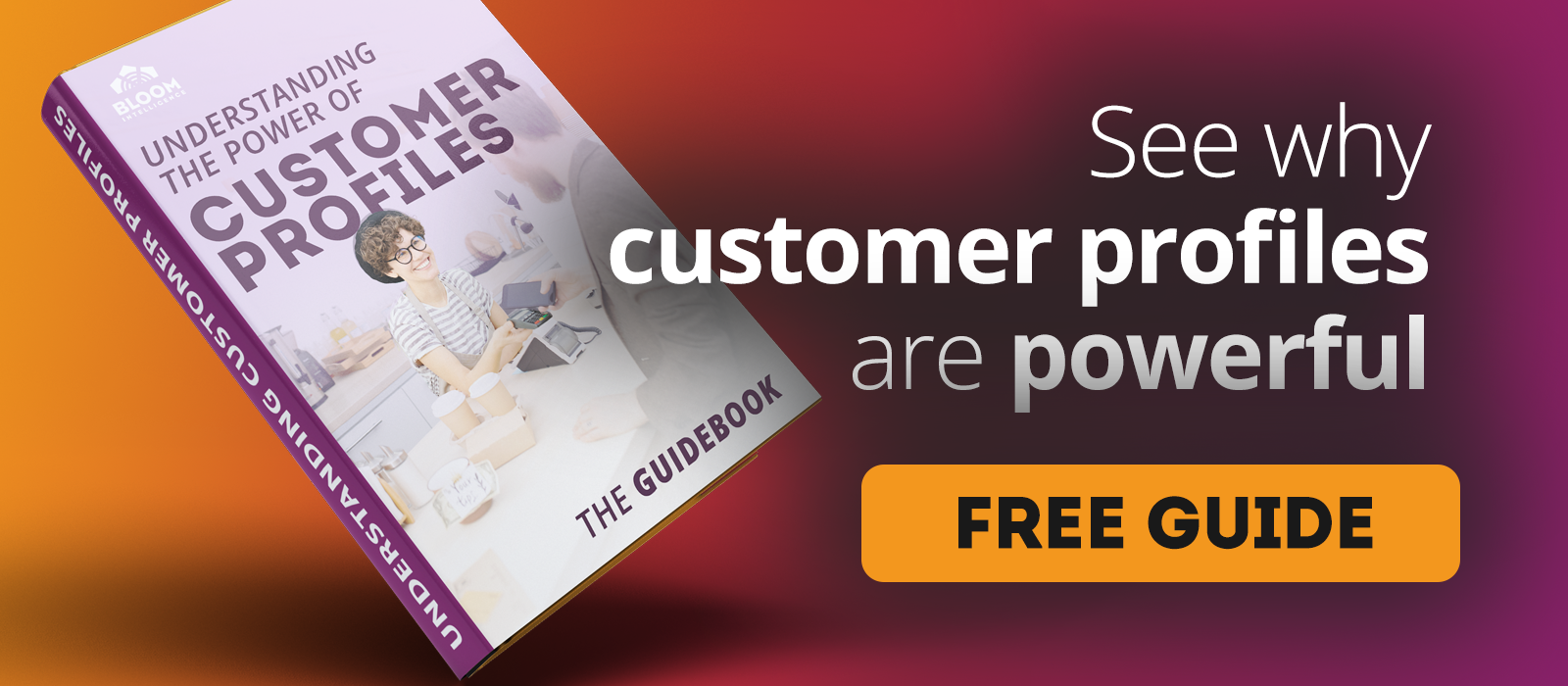Single Customer View for Restaurants
Aggregate guest data from WiFi, websites, online ordering, social, and reviews to get a single customer view to help turn guests into regulars.

Scroll to explore
What is a Single Customer View?
When it comes to restaurant marketing in today’s economy, a focus on data-driven marketing and remarketing is important.
Gathering data about your customer base has become more important than ever. Gathering that data and behavior from your guest-facing tech stack can drive sales.
It allows you to personalize your marketing messages and target individual guests with specific messaging that they are more likely to engage with.
Consumers today not only want more personalized messaging, but they expect it.
 A single customer view is a term used in business to describe a unified view of all the data associated with a guest. This can include data and behavior from different sources, such as WiFi logins, online ordering or reservations platforms, POS systems, website engagement, etc.
A single customer view is a term used in business to describe a unified view of all the data associated with a guest. This can include data and behavior from different sources, such as WiFi logins, online ordering or reservations platforms, POS systems, website engagement, etc.
By having a single customer view, restaurants can more easily identify opportunities and trends, individually and as a whole, and better serve their guests.
The benefits of having a single customer view are clear. But achieving this goal can be challenging without software, as it requires integrating data from multiple sources into a single system.
How to Get a Single Customer View for Restaurants
One way to achieve a single customer view is to use a restaurant customer data platform (CDP). A CDP is a centralized database containing all the guest data and behavior from an organization’s various systems.
This data can then be accessed and analyzed all in one place. The main advantage of using a CDP is that it provides a single point of view for all of an organization’s data.
Then you can use it to make data-driven, intelligent marketing and operations decisions and track their effectiveness over time.
The single-customer view will vary depending on the technology tools each restaurant uses. But regardless of this, the benefits of having a single customer view can make a huge difference in creating regulars and driving sales.
What Types of Data can be Collected for Restaurants?
- Guest Behavior Data – This type of data can range from actual visit behavior, such as dwell times, visit days, and popular visit times, to things like purchase frequency and how each guest interacts with your brand (online order, WiFi login, location visit behavior, offers redeemed, etc.).
- Transactional Data – this type of data is typically tied to each guest through an integration with a POS system or online marketing. It can also include which offers the guest has redeemed and the
- Demographic Data – this includes data such as age, gender, and postal code. It could also include contact information such as email address and phone number.
- Social Media Data – this data is gathered when a guest logs into your location’s WiFi using a social media account like Facebook. Data is collected only if the guest has allowed sharing on that account. It can also include demographic data included in the list above.
- Reputation Management Data – Bloom Intelligence integrates with Facebook and Google to allow restaurants to see ratings and reviews in real time. Each rating and review is stored in each guest’s customer profile. The data is also aggregated to see a real-time view and trending data about how your overall ratings are given.
For restaurants, having comprehensive guest data across all platforms allows them to see a full 360-degree view of their customer base.
This not only provides a way to understand the overall (and individual) guest experience but also provides benefits to your marketing and operations decisions and procedures.
Benefits of a Restaurant Single Customer View
The benefits of using a single customer view can do wonders for your restaurant business.
Some of the benefits of using a single customer view include:
- Easier identification of trends and opportunities
- Improved customer service
- A better understanding of guest behavior
- More efficient marketing campaigns
- Lower food and labor costs.
Easier Identification of Trends and Opportunities
With a single customer view, you will have an easy-to-understand graphical interface to view trends like guest dwell times, repeat rates, and churn rates.
Using this data, you can make intelligent, data-driven decisions about how to move forward with marketing and operations. It allows you to see how your guests are responding to your efforts.
Then, you can see how your improvements are working in real-time as the platform gathers data in real-time.
Improved Customer Service
Being able to see how your guests are behaving and what ratings and reviews they are leaving, you will have immediate insight into how your customer service is performing.
Using Bloom’s customer sentiment word cloud, you’ll quickly see what aspects of customer service need improvement and what works well.
Then, you can adjust your training and culture to bolster the good while improving the bad.
Better Understanding of Guest Behavior
As a restaurant owner or operator, it is important to know how your guests are behaving – both online and offline – toward your business while they are engaging with your brand.
Using a restaurant customer data platform, you will know, in real-time, how your guests are behaving.
You’ll easily see positive and negative trends and be able to react immediately to the negative while supporting the positive.
You can see things like:
- Guest dwell times
- Dwell times by hour
- First-time guests
- Guest repeat rates
- Guest attrition rates
- Popular days and times, and more.
Again, with this kind of deep customer insight, you can further improve your restaurant business while watching results in real-time.
More Efficient Marketing Campaigns
Restaurant marketing can be a difficult endeavor without solid, verified data.
With a single customer view, it becomes possible to segment your guest database into groups of similar guests based on behavior and demographic data.
Then you can send your marketing campaigns to each group with messaging that will resonate with them. This will lead to better engagement rates and more guests returning to your restaurant.
This segmented marketing has been proven to be much more effective than sending a single message to your entire database.
Plus, with a CDP like Bloom Intelligence, it is very easy to do. Once set up, all you need to do is monitor the results in the detailed reporting tools and make changes to your messaging to optimize over time.
Lower Food and Labor Costs
When you can easily see your busiest days and times and how much guests are spending at particular times, you can adjust your food & drink purchasing and labor to more closely match actual demand.
With accurate insight into how your guests behave, you can purchase and schedule more accurately to avoid 86’ing menu items or having to waste food.
Likewise, you can schedule your staff more appropriately and save on the rising costs of labor.
Discover Bloom Intelligence
If you are ready to start building your own powerful restaurant customer data platform and collecting guest data from your channels, look at Bloom Intelligence.
You’ll build your single customer view in no time!
By building your own restaurant customer data platform, you will take control of your guest data and unlock guest insights that will improve the success of your business.
Then, combine this with our unified WiFi marketing automation and reputation management to save time with automation, and money with the consolidation of services into one unified platform, increasing your guest lifetime values.
In today’s competitive environment, Bloom can give you the competitive edge for success!
If you’d like to see the Bloom restaurant marketing platform in action and discover how you can grow your business through guest intelligence and marketing automation, schedule a free demo or call 727-877-8181.
SAVE TIME, INCREASE CUSTOMER LIFETIME VALUES, CREATE NEW CUSTOMERS
What our happy customers
are saying
“SaaS that covered so many bases for us instead of having to use multiple software products. Bloom Intelligence has simplified our responses to reviews, customer feedback, and more. I highly recommend Bloom Intelligence.”
Robert Sanderson
“Bloom Intelligence really is a step ahead in terms of marketing software and metrics. Their product is reliable, fast and innovative and has helped the company I work for really grow.”
John Marchetti
“Working with Bloom Intelligence has been amazing. They assist you every step of the way and work with you hand in hand to make sure you are optimizing your advertising potential. We are excited to use this tool to help learn more about our customers so that we can personally engage with them and understand our strengths/weaknesses.”
Ariel Ramirez
“In these challenging times, it has been a pleasure working with Bloom Intelligence to help facilitate our service offering to our clients. They were extremely responsive and provided support to mitigate risk and minimize revenue loss. Great partner!”
Stefan Kim
“We’re extremely pleased with the wealth of customer data that we’re able to gather, at a very attractive price. In addition, we’re able to communicate our new product promotions by using the landing page as a digital billboard. A “no-brainer” for anyone working with limited Marketing $$.”
Bob Cross, Vice President of Operations
Restaurant Customer Data Platform FAQs
What Does CDP Stand For?
CDP stands for Customer Data Platform. To summarize, a CRM database is a collection of guest data grouped into customer profiles. So, a CRM can be used to understand your customer base, and for segmented, targeted marketing campaigns that can be tracked for accurate attribution.
What is a CRM Database?
A CRM Database is a digital collection of individual guest information grouped into customer profiles. Likewise, the database consists of detailed guest data such as names, behavior data, demographics, addresses, zip codes, emails, and phone numbers. As a result, these profiles are used to track communication and to remarket to guests.
What are Examples of a CRM Database?
For example, a CRM database for offline companies is the Bloom Intelligence CRM database. For example, using guest WiFi access points & guest WiFi landing pages, the platform collects guest behavior data, whether they log into WiFi or not, and builds detailed customer profiles for marketing and attribution. By comparison, other popular CRM’s include Salesforce, Microsoft Dynamic, and Hubspot.
How Do I Create a CRM Database?
For restaurant and retail locations, the easiest and best way to create a CRM database is to use your WiFi access points, Guest WiFi landing page, website widgets, and API’s to collect guest information and behavior data. Then, once configured, your guest data is collected and cleaned automatically.
The Power of a Restaurant Customer Data Platform

Optimize retail &
business operations

Track attribution of
customer campaigns

Trigger marketing
campaigns based on
marketing presence

Measure the health
of corporate & franchisee
locations

Compare locations or
group of locations to
quickly identify opportunities
or threats
Are you ready to grow
your business with a
restaurant CDP and
Wifi marketing automation?
If so, find out how Bloom Intelligence’s WiFi analytics
& marketing platform measures offline guest
behavior and builds guest loyalty.
So, it’s time to start leveraging your guest WiFi to gain
a competitive edge. Then watch your profits grow.




